Use the following information to answer the question(s) below.
In the United States and Canada, bats use one of two strategies to survive winter: They either migrate south, or they hibernate. Recently, those that hibernate seem to have come under attack by a fungus, Geomyces destructans (Gd), an attack that is occurring from Missouri to southern Canada. Many infected bats have a delicate, white filamentous mat on their muzzles, which is referred to as white-nose syndrome (WNS). The fungus invades the bat tissues, causes discomfort, and awakens the bat from its hibernation. The bat fidgets and wastes calories, using up its stored fat. The bat then behaves abnormally, leaving its cave during daytime in winter to search for food. Their food, primarily insects, is scarce during the winter, and the bats ultimately starve to death. Since 2007, it is estimated that up to one million bats have perished from WNS.
1) The Gd mat on the fur of the bats should be expected to consist of _____.
hyphae
What do fungi and arthropods have in common?
Both groups use chitin for support.
Fungi have an extremely high surface-area-to-volume ratio. What is the advantage of this to an organism that gets most of its nutrition through absorption?
The larger surface area allows for more material to be transported through the cell membrane.
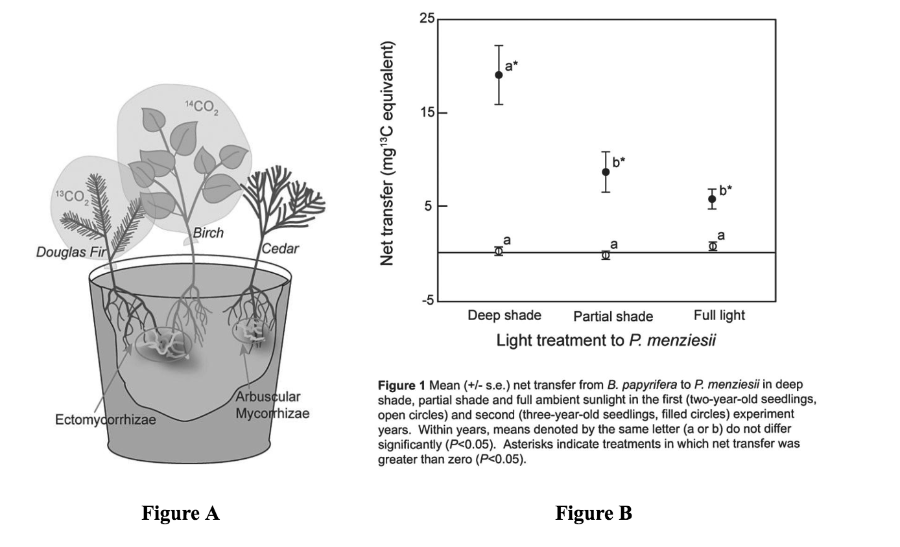
Use the following information to answer the question(s) below.
Suzanne Simard and colleagues knew that the same mycorrhizal fungal species could colonize multiple types of trees. They wondered if the same fungal individual would colonize different trees, forming an underground network that potentially could transport carbon and nutrients from one tree to another (S. Simard et al. 1997. Net transfer of carbon between mycorrhizal tree species in the field. Nature 388:579-82).
Figure A illustrates the team's experimental setup. Pots containing seedlings of three different tree species were set up and grown under natural conditions for three years; two of the three species (Douglas fir, birch) formed ectomycorrhizae and the other (cedar) formed arbuscular mycorrhizae. For the experiment, the researchers placed airtight bags over the Douglas fir and birch seedlings; into each bag, they injected either carbon dioxide made from carbon-13 or carbon-14 (13CO2 and 14CO2, isotopes of carbon). As the seedlings photosynthesized, the radioactive carbon dioxide was converted into radioactively labeled sugars that could be tracked and measured by the researchers.
4) Refer to Figure A. Which of the following results would support Simard et al.'s (1997) hypothesis that fungi can move carbon from one plant to another? [Hypothesis: Sugars made by one plant during photosynthesis can travel through a mycorrhizal fungus and be incorporated into the tissues of another plant.]
Carbon-14 is found in the Douglas fir seedling's tissues and carbon-13 in the birch.
Based on the idea that fungi have pores between their cell walls, which allow cytoplasm to move from one end of the mycelium to the other, which of the following hypotheses is the most plausible?
If a single mycorrhizal fungus formed symbiotic associations with more than one tree, carbon could travel from one plant to another.
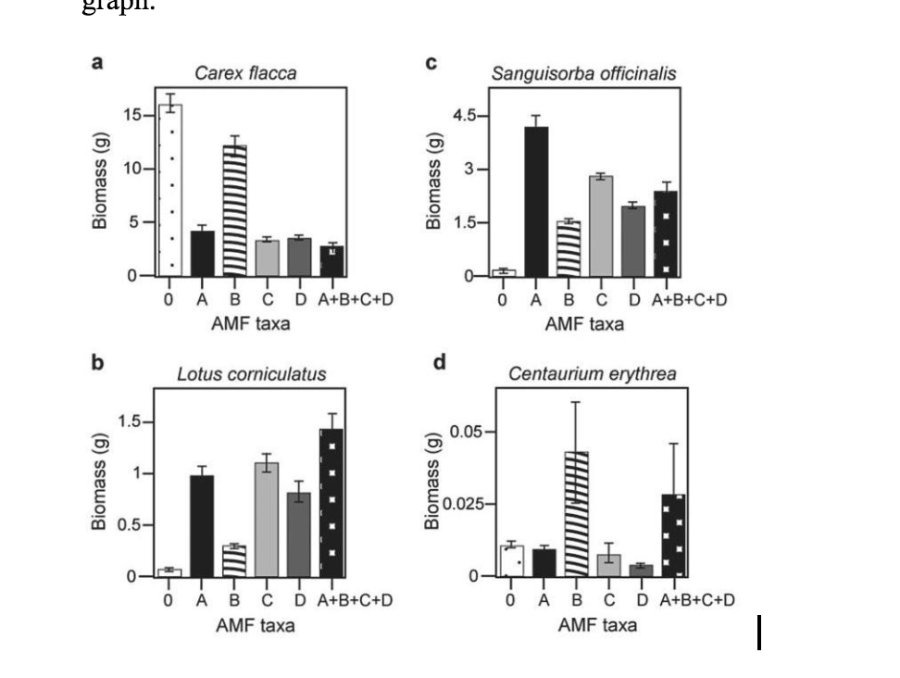
Use the following information to answer the question(s) below.
There is much discussion in the media about protecting biodiversity. But does biodiversity really matter? Canadian and Swiss researchers wanted to know if the diversity of arbuscular mycorrhizal fungi (AMF) was important to the productivity of grasslands (M.G.A. van der Heijden, J. N. Klironomos, M. Ursic, P. Moutoglis, R. Streitwolf-Engel, T. Boler, A. Wiemken, and I. R. Sanders. 1998. Mycorrhizal fungal diversity determines plant biodiversity, ecosystem variability and productivity. Nature 396:69-72). Specifically, they wanted to know if it mattered which specific AMF species were present, or just that some type of AMF was present. They grew various plants in combination with one of four AMF species (A, B, C, and D), no AMF species (O), or all four AMF species together (A+B+C+D); and they measured plant growth under each set of conditions. All plant species were grown in each plot, so they always competed with each other with the only difference being which AMF species were present.
On the graphs below, the x-axis labels indicate the number and identity of AMF species (bar 0 = no fungi; bars A-D = individual AMF species; bar A+B+C+D = all AMF species together). The y-axis indicates the amount (grams) of plant biomass for the species shown in italics above each graph.
6) Based on the graphs in the figure above, which of the following plant species is most likely NOT to form mycorrhizal associations?
Carex flacca (graph a)
If all fungi in an environment that perform decomposition were to suddenly die, then which group of organisms should benefit most, due to the fact that their fungal competitors have been removed?
prokaryotes
When a mycelium infiltrates an unexploited source of dead organic matter, what are most likely to appear within the food source soon thereafter?
fungal enzymes
The functional significance of porous septa in certain fungal hyphae is most similar to that represented by which pair of structures in animal cells and plant cells, respectively?
gap junctions — plasmodesmata
A fungal spore germinates, giving rise to a mycelium that grows outward into the soil surrounding the site where the spore originally landed. Which of the following accounts for the fungal movement, as described here?
cytoplasmic streaming in hyphae
When pathogenic fungi are found growing on the roots of grape vines, grape farmers sometimes respond by covering the ground around their vines with plastic sheeting and pumping a gaseous fungicide into the soil. The most important concern of grape farmers who engage in this practice should be that the _____.
fungicide might also kill mycorrhizae
The adaptive advantage associated with the filamentous nature of fungal mycelia is primarily related to _____.
an extensive surface area well suited for invasive growth and absorptive nutrition
Some fungal species can kill herbivores while feeding off of sugars from its plant host. What type of relationship does this fungus have with its host?
mutualistic
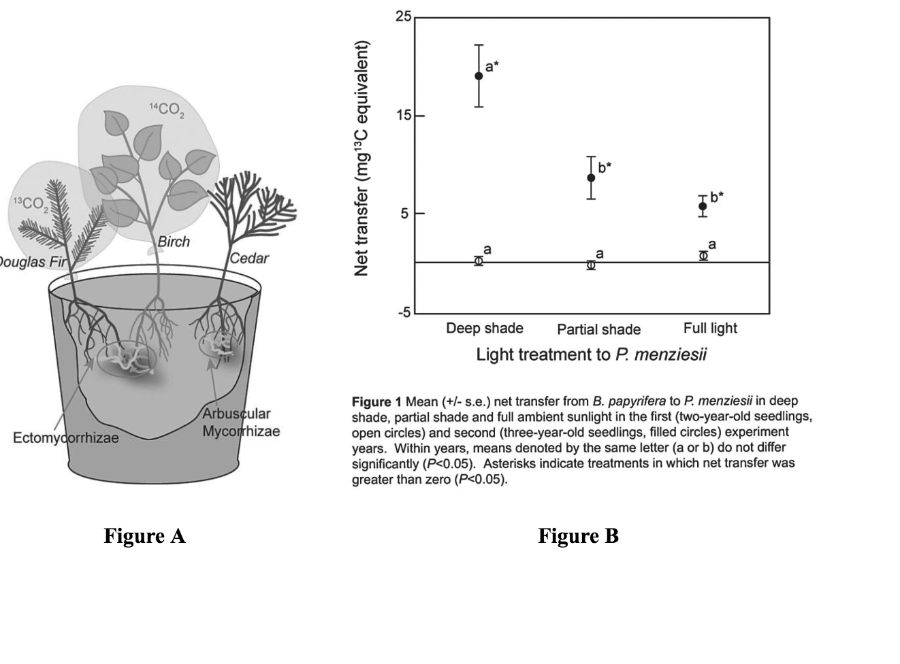
Use the following information to answer the question(s) below.
Suzanne Simard and colleagues knew that the same mycorrhizal fungal species could colonize multiple types of trees. They wondered if the same fungal individual would colonize different trees, forming an underground network that potentially could transport carbon and nutrients from one tree to another (S. Simard et al. 1997. Net transfer of carbon between mycorrhizal tree species in the field. Nature 388:579-82).
Figure A illustrates the team's experimental setup. Pots containing seedlings of three different tree species were set up and grown under natural conditions for three years; two of the three species (Douglas fir, birch) formed ectomycorrhizae and the other (cedar) formed arbuscular mycorrhizae. For the experiment, the researchers placed airtight bags over the Douglas fir and birch seedlings; into each bag, they injected either carbon dioxide made from carbon-13 or carbon-14 (13CO2 and 14CO2, isotopes of carbon). As the seedlings photosynthesized, the radioactive carbon dioxide was converted into radioactively labeled sugars that could be tracked and measured by the researchers.
Referring to Simard et al. (1997), what is the result that would most strongly refute their hypothesis? [Hypothesis: Sugars made by one plant during photosynthesis can travel through a mycorrhizal fungus and be incorporated into the tissues of another plant.]
Either carbon-13 or carbon-14 is found in the cedar seedling's tissues.
Referring to Simard et al. (1997), which design element is the control in this experiment and why?
the cedar seedling, because it forms arbuscular mycorrhizae
Simard et al. (1997) further hypothesized that if reciprocal transfer did occur, it would be a source-sink relationship driven by photosynthetic rates. That is, if one seedling is in full sun and the other in deep shade, there will be a net movement of carbon from the seedling in full sun to the one in deep shade. If a shade was placed over the birch seedlings and the cedar, and the Douglas fir was left in full sun, what result could Simard and colleagues expect?
More 13C would be found in the birch than in the Douglas fir.

Use the following information to answer the question(s) below.
There is much discussion in the media about protecting biodiversity. But does biodiversity really matter? Canadian and Swiss researchers wanted to know if the diversity of arbuscular mycorrhizal fungi (AMF) was important to the productivity of grasslands (M.G.A. van der Heijden, J. N. Klironomos, M. Ursic, P. Moutoglis, R. Streitwolf-Engel, T. Boler, A. Wiemken, and I. R. Sanders. 1998. Mycorrhizal fungal diversity determines plant biodiversity, ecosystem variability and productivity. Nature 396:69-72). Specifically, they wanted to know if it mattered which specific AMF species were present, or just that some type of AMF was present. They grew various plants in combination with one of four AMF species (A, B, C, and D), no AMF species (O), or all four AMF species together (A+B+C+D); and they measured plant growth under each set of conditions. All plant species were grown in each plot, so they always competed with each other with the only difference being which AMF species were present.
On the graphs below, the x-axis labels indicate the number and identity of AMF species (bar 0 = no fungi; bars A-D = individual AMF species; bar A+B+C+D = all AMF species together). The y-axis indicates the amount (grams) of plant biomass for the species shown in italics above each graph.
17) Based on the van der Heijden et al. (1998) graphs in the figure above, which of the following is the best description of the data supporting the idea that a plant species did not form mycorrhizae with a fungus? Its biomass is greatest when _____.
no AMF are present

In graph (b) in the figure above, which of the following best explains the data given about Lotus corniculatus?
This plant forms multiple AMF associations, growing best with increased fungal diversity.
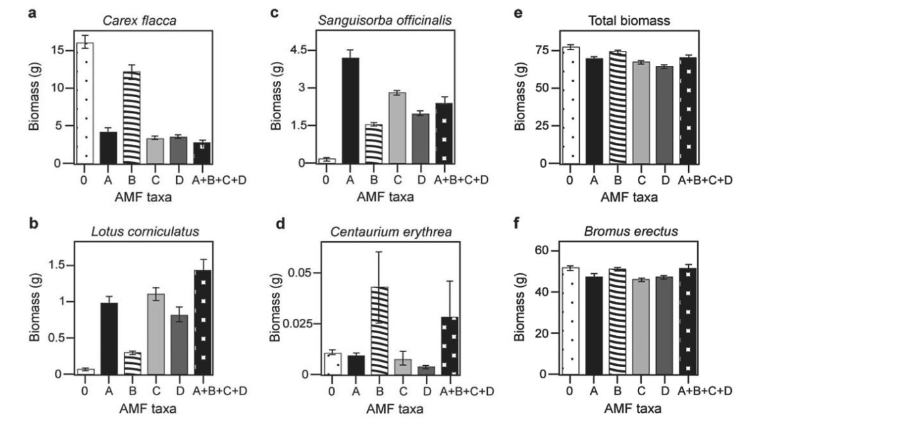
Use the following information to answer the question(s) below.
Canadian and Swiss researchers wanted to know if the diversity of arbuscular mycorrhizal fungi (AMF) was important to the productivity of grasslands (M.G.A. van der Heijden, J. N. Klironomos, M. Ursic, P. Moutoglis, R. Streitwolf-Engel, T. Boler, A. Wiemken, and I. R. Sanders. 1998. Mycorrhizal fungal diversity determines plant biodiversity, ecosystem variability and productivity. Nature 396:69-72). Specifically, they wanted to know if it mattered which specific AMF species were present, or just that some type of AMF was present. They grew various plants in combination with one of four AMF species (A, B, C, & D), no AMF species (O), or all four AMF species together (A+B+C+D); and they measured plant growth under each set of conditions. All plant species were grown in each plot, so they always competed with each other with the only difference being which AMF species were present.
On the graphs below, the x-axis labels indicate the number and identity of AMF species (bar 0 = no fungi; bars A-D = individual AMF species; bar A+B+C+D = all AMF species together). The y-axis indicates the amount (grams) of plant biomass for the species shown in italics above each graph. Graph (e) is the total biomass (grams) of all 11 plant species combined; graph (f) is the biomass of Bromus erectus plants only, separated from the total.
19) What is the major difference between Bromus erectus (graph f) and the other plant species (graphs a-d) included in the study?
Bromus erectus is unaffected by AMF diversity.

Why does total biomass (graph e in the figure above) not vary with AMF diversity?
Bromus erectus is the dominant plant species.

Based on graphs (e) and (f) in the figure above, which is the most well-supported prediction for the effect on total plant biomass if AMF diversity were increased to eight species?
No effect is predicted, because the dominant species is unaffected by AMF diversity.
At which stage of a basidiomycete's life cycle would reproduction be halted if an enzyme that prevented the fusion of hyphae was introduced?
plasmogamy
Deuteromycetes _____.
are the group of fungi that have, at present, no known sexual stage
Use the following information to answer the question(s) below.
For several decades now, amphibian species worldwide have been in decline. A significant proportion of the decline seems to be due to the spread of the chytrid fungus, Batrachochytrium dendrobatidis (Bd). Chytrid sporangia reside within the epidermal cells of infected animals, animals that consequently show areas of sloughed skin. They can also be lethargic, which is expressed through failure to hide and failure to flee. The infection cycle typically takes four to five days, at the end of which zoospores are released from sporangia into the environment. In some amphibian species, mortality rates approach 100%; other species seem able to survive the infection.
24) Sexual reproduction has not been observed in Bd. If its morphology and genetics did not identify it as a chytridiomycete, then to which fungal group would Bd be assigned?
deuteromycetes
Plasmogamy can directly result in which of the following?
- cells with a single haploid nucleus
- heterokaryotic cells
- dikaryotic cells
- cells with two diploid nuclei
2 or 3
After cytokinesis occurs in budding yeasts, the daughter cell has a _____.
similar nucleus and less cytoplasm than the mother cell
In most fungi, karyogamy does not immediately follow plasmogamy, which consequently _____.
results in heterokaryotic or dikaryotic cells
Asexual reproduction in yeasts occurs by budding. Due to unequal cytokinesis, the "bud" cell receives less cytoplasm than the parent cell. Which of the following should be true of the smaller cell until it reaches the size of the larger cell?
It should produce fewer fermentation products per unit time.
The microsporidian Brachiola gambiae parasitizes the mosquito Anopheles gambiae. Adult female mosquitoes must take blood meals for their eggs to develop, and it is while they take blood that they transmit malarial parasites to humans. Male mosquitoes drink flower nectar. If humans are to safely and effectively use Brachiola gambiae as a biological control to reduce human deaths from malaria, then how many of the following statements should be true?
- Brachiola should kill the mosquitoes before the malarial parasite they carry reaches maturity.
- The microsporidian should not be harmful to other insects.
- Microsporidians should infect mosquito larvae, rather than mosquito adults.
- The subsequent decline in anopheline mosquitoes should not significantly disrupt human food resources or other food webs.
- Brachiola must be harmful to male mosquitoes, but not to female mosquitoes.
1, 2, and 4
Why are mycorrhizal fungi superior to plants at acquiring mineral nutrition from the soil?
Fungi secrete extracellular enzymes that can break down large molecules.
Fossil fungi date back to the origin and early evolution of plants. What combination of environmental and morphological change is similar in the evolution of both fungi and plants?
colonization of land and loss of flagellated cells
The multicellular condition of animals and fungi seems to have arisen _____.
by convergent evolution
Which feature seen in chytrids supports the hypothesis that they diverged earliest in fungal evolution?
flagellated spores
Recent genetic studies of the structure of microsporidian genomes, as well as the sequences of their tubulin genes and the gene for RNA polymerase II, indicate that microsporidians are closely related to the fungi. Microsporidians lack flagella, centrioles, peroxisomes, and mitochondria (although they do have degenerate mitochondria, called mitosomes). They have the smallest genome of any eukaryote, and it is a genome that changes quickly. The genome is contained within two haploid nuclei. All microsporidians are obligate intracellular parasites. They use a unique organelle called a polar filament to gain access to the cells of their hosts. One species causes chronic diarrhea in AIDS patients. Another parasitizes Anopheles gambiae, the mosquito that transmits a fatal form of malaria to humans.
34) Given the eukaryotic structures they lack, it should be expected that microsporidians also lack _____.
the "9 + 2 pattern" of microtubules
It has been hypothesized that fungi and plants have a mutualistic relationship because plants make sugars available for the fungi's use. What is the best evidence in support of this hypothesis?
Radioactively labeled sugars produced by plants eventually show up in the fungi with which they are associated.
You observe the gametes of a fungal species under the microscope and realize that they resemble animal sperm. To which of the following group does the fungus belong?
Chytrids
Which of the following has the LEAST affiliation with all of the others?
lichens
Arrange the following in order from largest to smallest.
- ascospore
- ascocarp
- ascomycete
- ascus
3 → 2 → 4 → 1
Arrange the following in order from largest to smallest, assuming that they all come from the same fungus.
- basidiocarp
- basidium
- basidiospore
- mycelium
- gill
4 → 1 → 5 → 2 → 3
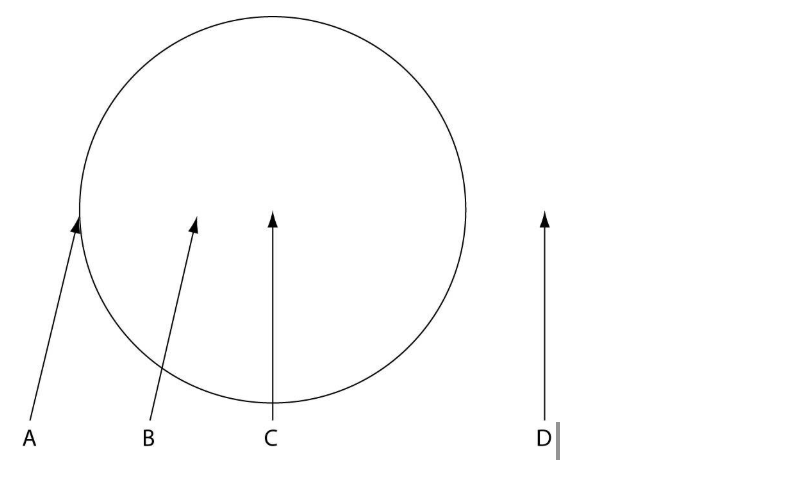
The following figure depicts the outline of a large fairy ring that has appeared overnight in an open meadow, as viewed from above. The fairy ring represents the furthest advance of this mycelium through the soil. Locations A-D are all 0.5 meters below the soil surface.
40) What is the most probable location of the oldest portion of this mycelium?
c

Which location is nearest to basidiocarps?
A

At which location is the mycelium currently absorbing the most nutrients per unit surface area, per unit time?
A

At which location should one find the lowest concentration of fungal enzymes, assuming that the enzymes do not diffuse far from their source, and that no other fungi are present in this habitat?
D

Assume that all four locations are 0.5 meters above the surface. On a breezy day with prevailing winds blowing from left to right, where should one expect to find the highest concentration of free basidiospores in an air sample?
D

If the fungus that produced the fairy ring can also produce arbuscules, then which of the following is most likely to be buried at location "C"?
tree stump
Use the following information to answer the question(s) below.
For several decades now, amphibian species worldwide have been in decline. A significant proportion of the decline seems to be due to the spread of the chytrid fungus, Batrachochytrium dendrobatidis (Bd). Chytrid sporangia reside within the epidermal cells of infected animals, animals that consequently show areas of sloughed skin. They can also be lethargic, which is expressed through failure to hide and failure to flee. The infection cycle typically takes four to five days, at the end of which zoospores are released from sporangia into the environment. In some amphibian species, mortality rates approach 100%; other species seem able to survive the infection.
46) Apart from direct amphibian-to-amphibian contact, what is the most likely means by which the zoospores spread from one free-living amphibian to another?
by flagella
When adult amphibian skin harbors populations of the bacterium, Janthinobacterium lividum (Jl), chytrid infection seems to be inhibited. Which of the following represents the best experimental design to test whether this inhibition is real?
Take infected amphibians and assign them to two populations. Leave one population alone; inoculate the other with Jl. Measure the rate at which infection proceeds in both populations.
A researcher took water in which a Jl population had been thriving, filtered the water to remove all bacterial cells, and then applied the water to the skins of adult amphibians to see if there would subsequently be a reduced infection rate by Bd when frog skins were inoculated with Bd. For which of the following hypotheses is the procedure described a potential test?
the hypothesis that a toxin secreted by Jl cells kills Bd cells when both are present together on frog skin
Basidiomycetes are the only fungal group capable of synthesizing lignin peroxidase. What advantage does this group of fungi have over other fungi because of this capability?
This fungal group can break down the tough lignin, which cannot be harnessed for energy, to get to the more useful cellulose.
Use the following information to answer the question(s) below.
For several decades now, amphibian species worldwide have been in decline. A significant proportion of the decline seems to be due to the spread of the chytrid fungus, Batrachochytrium dendrobatidis (Bd). Chytrid sporangia reside within the epidermal cells of infected animals, animals that consequently show areas of sloughed skin. They can also be lethargic, which is expressed through failure to hide and failure to flee. The infection cycle typically takes four to five days, at the end of which zoospores are released from sporangia into the environment. In some amphibian species, mortality rates approach 100%; other species seem able to survive the infection.
50) If Bd cannot grow properly at temperatures above 28°C (82°F), then, assuming the amphibians can survive, in which time or place should the chytrid infection proceed most rapidly?
- cooler months
- warmer months
- lower altitudes
- higher altitudes
1 or 4
Use the following information to answer the question(s) below.
Diploid nuclei of the ascomycete, Neurospora crassa, contain 14 chromosomes. A single diploid cell in an ascus will undergo one round of meiosis, followed in each of the daughter cells by one round of mitosis, producing a total of eight ascospores.
51) If a single, diploid G2 nucleus in an ascus contains 400 nanograms (ng) of DNA, then a single ascospore nucleus of this species should contain how much DNA (ng), carried on how many chromosomes?
100, carried on 7 chromosomes
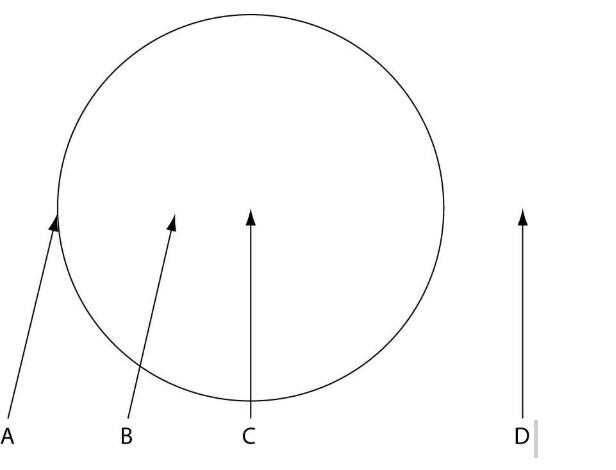
The following figure depicts the outline of a large fairy ring that has appeared overnight in an open meadow, as viewed from above. The fairy ring represents the furthest advance of this mycelium through the soil. Locations A-D are all 0.5 meters below the soil surface.
52) In which of the following human mycoses should one expect to find a growth pattern most similar to that of the mycelium that produced the fairy ring?
skin mycoses
Use the following information to answer the question(s) below.
Rose-picker's disease is caused by the yeast Sporothrix schenkii (S. schenkii). The yeast grows on the exteriors of rose-bush thorns. If a human gets pricked by such a thorn, the yeasts can be introduced under the skin. The yeasts then assume a hyphal morphology and grow along the interiors of lymphatic vessels until they reach a lymph node. This often results in the accumulation of pus in the lymph node, which subsequently ulcerates through the skin surface and then drains.
53) Humans have immune systems in which lymph nodes are important, because many phagocytes and lymphocytes reside there. Given that a successful infection by S. schenkii damages lymph nodes themselves, which of the following is most probable?
Their conversion from yeast to hyphal morphology allows such fast growth that the body's defenses are at least temporarily overwhelmed.
If haustoria from the fungal partner were to appear within the photosynthetic partner of a lichen, and if the growth rate of the photosynthetic partner consequently slowed substantially, then this would support the claim that _____.
lichens are not purely mutualistic relationships
A billionaire buys a sterile volcanic island that recently emerged from the sea. To speed the arrival of conditions necessary for plant growth, the billionaire might be advised to aerially sow what over the island?
soredia
Orchid seeds are tiny, with virtually no endosperm and with miniscule cotyledons. If such seeds are deposited in a dark, moist environment, then which of the following represents the most likely means by which fungi might assist in seed germination, given what the seeds lack?
by providing the embryos with some of the organic nutrients they have absorbed
Use the following information to answer the question(s) below.
Rose-picker's disease is caused by the yeast Sporothrix schenkii (S. schenkii). The yeast grows on the exteriors of rose-bush thorns. If a human gets pricked by such a thorn, the yeasts can be introduced under the skin. The yeasts then assume a hyphal morphology and grow along the interiors of lymphatic vessels until they reach a lymph node. This often results in the accumulation of pus in the lymph node, which subsequently ulcerates through the skin surface and then drains.
57) The answer to which of these questions would be of most assistance to one who is attempting to assign the genus Sporothrix to the correct fungal phylum?
Does S. schenkii rely on animal infection to complete some part of its life cycle, or is the infection merely opportunistic?
Suppose that S. schenkii had initially been classified as a deuteromycete. Asci were later discovered in the pus that oozed from an ulcerated lymph node, and the spores therein germinated, giving rise to S. schenkii yeasts. Which two of these are conclusions make sense on the basis of this information?
- S. schenkii produces asexual spores within lymph nodes.
- S. schenkii should be reclassified.
- S. schenkii continues to have no known sexual stage.
- The hyphae growing in lymphatic vessels probably belonged to a different fungal species.
- S. schenkii yeasts belonging to two different mating strains were introduced by the same thorn prick.
2 and 5
Which of the following best describes the physical relationship of the partners involved in lichens?
Photosynthetic cells are surrounded by fungal hyphae.
Mycorrhizae are to the roots of vascular plants as endophytes are to vascular plants' _____.
leaf mesophyll